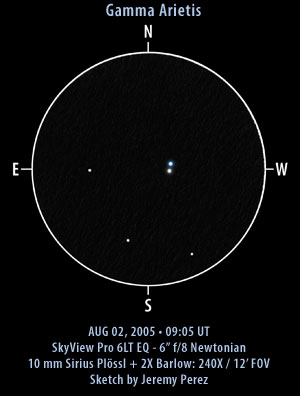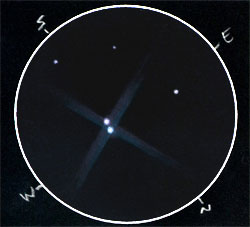
Sketch Refinement
Above is the cleaned up sketch that was submitted to Sky and Telescope for the September 2006 issue.
August 7, 2005 Observation

Observation Notes:
This was a stunning pair. They were so close in magnitude, I couldn't tell the primary. At low power, both looked light blue. But at high power, I'd say the northern star was light blue while the southern star was white. If anything, the northern star may be a touch brighter. I estimated PA at 170° and separation at 8". Listed values from the AL double star list are 0° and 7.8". Not bad at all on the separation estimate! Apparently, they have the southern star pegged as the brighter one, so my PA should actually be 350°. Now, I've grown accustomed to my PA value being off by as much as 10°, but I'm positive these stars didn't line up perfectly north - south. I checked the WDS catalog and a value of 356° was given, so I'm somewhat vindicated there. Not that I need to be vindicated. Uh. Where was I?
| Subject | Double/Multiple Star: Gamma Arietis (STF 180) |
| Classification | Triple Star |
| Position | Aries [RA: 01:53:30 / Dec: +19:18]* |
| Separation* | 7.8" |
| Magnitudes* | 4.8, 4.8 |
| Position Angle* | 0° |
| Date/Time | 08/02/05 - 2:05 AM |
| Observing Loc. | Flagstaff, AZ - Home |
| Instrument | Orion SVP 6LT Reflector (150 mm dia./1200 mm F/L) |
| Eyepieces/Mag. | 10 mm + 2X Barlow (240X) |
| Conditions | Partly cloudy, calm, 50°F |
| Seeing | 3/10 |
| Transparency | NELM Mag 5.8 |
*Based on published data.





I have seen several postings of yours on the Web. I am just starting to split and document double stars as my hobby and I am completely baffled by the system to define directions. I cannot understand how to define North or East when one might be looking through a 1.5 degree FOV toward the Southwest. Obviously, you know how to do this. I have found no help in references I have consulted, including Sky and Telescope magazine back issues. Can you shed some light on this convention to help me?
Mike Galvas
Hi Mike,
This is actually a very common question and can be pretty frustrating until you figure out the process. I'm traveling at the moment, and can't elaborate easily. I'll write more when I return. In the meantime, try googling something like:
Determine cardinal directions astronomy
And see what comes up.
I'll write more in a few days.
Jeremy